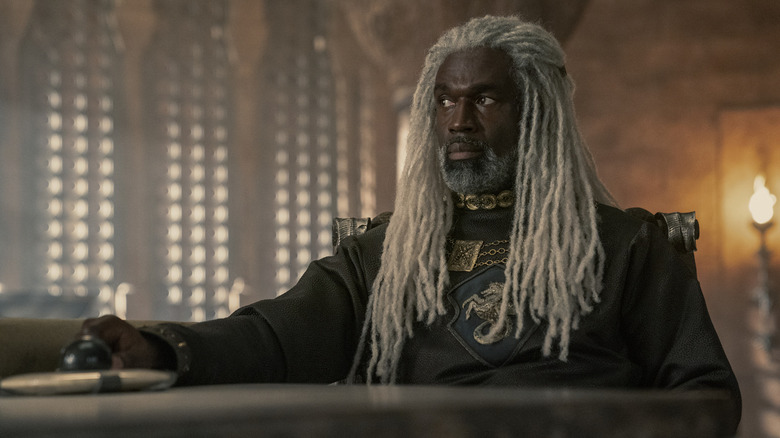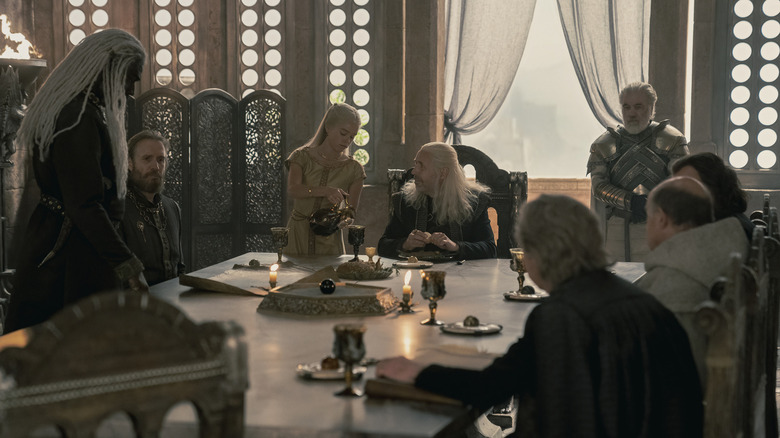House Of The Dragon: What Are The Stone Balls On The Small Council Table?
"House of the Dragon" Season 1 (which we've rewatched), spends a lot of time with King Viserys I Targaryen (Paddy Considine) and his small council, the group of advisors and governors who oversee affairs in King's Landing and Westeros at large. During the small council scenes in the Red Keep, you may have noticed that each member of the tribunal has a smooth, round stone that's placed before them on the table at the start of each meeting. These return on "House of the Dragon" Season 2, Episode 1, when the young Prince Jaehaerys confuses one for a toy.
The stone balls are exactly what they appear to be — markers of attendance. When each member arrives, their respective marble orb is placed in the dish before them. "It represented the council coming in and being part of the meeting," set decorator Claire Nie Richards told The Hollywood Reporter in 2022. "Everybody shows up for work and they 'punch in,'" showrunner Ryan Condal added. "I thought it was really cool. It's a way of visualizing the set formality of the [s]mall [c]ouncil chamber. It's enjoyable; we should have things that we like in this world." Since these stones don't appear on "Game of Thrones," it's safe to assume that the tradition fell out of fashion, or perhaps it was actively abolished when the Targaryens were overthrown.
Each stone is a different color, corresponding to the respective small council member and their role. When a member is notably absent, as Daemon Targaryen (Matt Smith) is at points on "House of the Dragon" Season 1, their stone remains in the center of the table, marking who's voice isn't being heard on that day.
The small council is all about tradition and symbolism
There are seven stone balls for the seven members of the small council, and if you know the world of A Song of Ice and Fire at all, you'll know that number is far from a coincidence. Seven is the most important number in Westeros for multiple reasons. For one, the realm's dominant religion revolves around worshipping a god with seven faces, or forms: the Father, the Mother, the Maiden, the Crone, the Warrior, the Smith, and the Stranger. This multifaceted deity is represented by the faith's core symbol, the Seven-Pointed Star. This is also why the priests who lead the religion are called septons, as "sept" means seven.
Of course, this isn't the only significance of the number seven in Westeros. The realm itself is often referred to as the Seven Kingdoms, though this moniker is a bit confusing. If you've seen "Game of Thrones" or read the novels, you've probably tried to figure out which kingdoms are actually being referenced. The North? Dorne? Do they belong to the great families of Westeros? That's all kind of right, but the full answer is a bit more complicated.
As outlined in the encyclopedic companion book "The World of Ice and Fire," the phrase "Seven Kingdoms" refers to the state of Westeros when Aegon the Conqueror first began warring to unite it. At the time, there were seven distinct kingdoms on the continent. Some, like the North, ruled by House Stark, stay consistent through to the point in time when "Game of Thrones" takes place. Houses Lannister, Arryn, and Martell each rules independent kingdoms as well, while the Stormlands, Reach, and Riverlands were all ruled by kings from families that would eventually be replaced after the Targaryen conquest.

